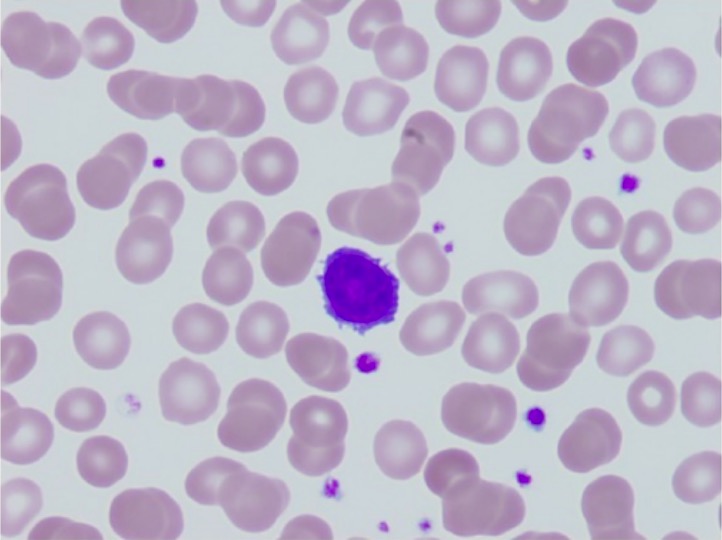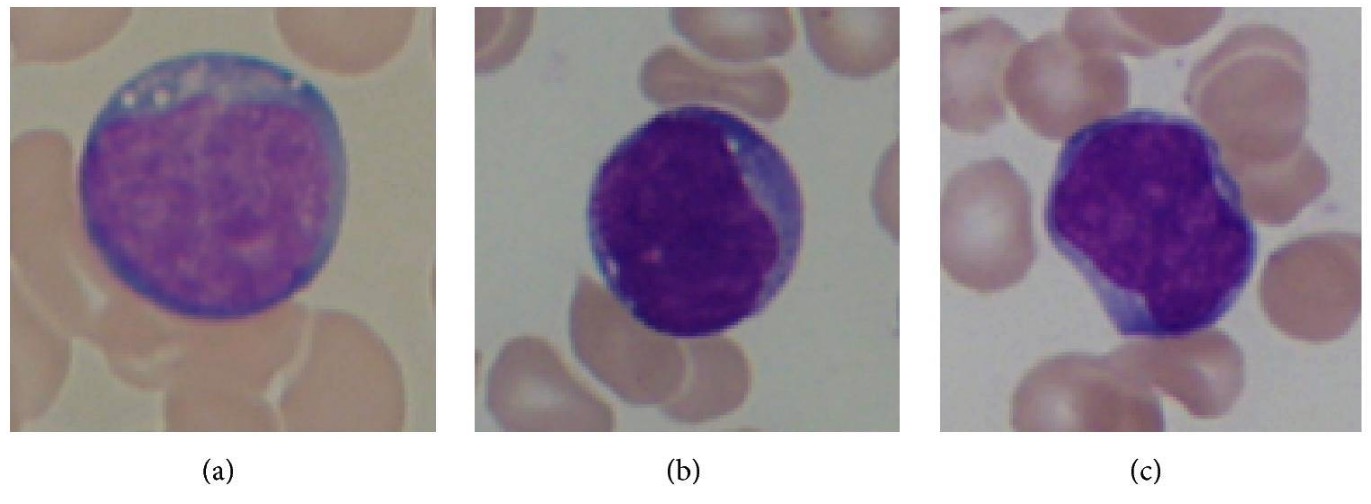WBCs develop from stem cells in the bone marrow Bone marrow The soft tissue filling the cavities of bones. Bone marrow exists in two types, yellow and red. Yellow marrow is found in the large cavities of large bones and consists mostly of fat cells and a few primitive blood cells. Red marrow is a hematopoietic tissue and is the site of production of erythrocytes and granular leukocytes. Bone marrow is made up of a framework of connective tissue containing branching fibers with the frame being filled with marrow cells. Bone Marrow: Composition and Hematopoiesis and are called leukocytes Leukocytes White blood cells. These include granular leukocytes (basophils; eosinophils; and neutrophils) as well as non-granular leukocytes (lymphocytes and monocytes). White Myeloid Cells: Histology when circulating in the bloodstream. Lymphocytes Lymphocytes Lymphocytes are heterogeneous WBCs involved in immune response. Lymphocytes develop from the bone marrow, starting from hematopoietic stem cells (HSCs) and progressing to common lymphoid progenitors (CLPs). B and T lymphocytes and natural killer (NK) cells arise from the lineage. Lymphocytes: Histology are 1 of the 5 subclasses of WBCs. Lymphocytosis is an increase in the number or proportion of the lymphocyte subclass of WBCs, often as a result of an immune response to infection (known as reactive lymphocytosis). Common presentations include fever Fever Fever is defined as a measured body temperature of at least 38°C (100.4°F). Fever is caused by circulating endogenous and/or exogenous pyrogens that increase levels of prostaglandin E2 in the hypothalamus. Fever is commonly associated with chills, rigors, sweating, and flushing of the skin. Fever, lymphadenopathy Lymphadenopathy Lymphadenopathy is lymph node enlargement (> 1 cm) and is benign and self-limited in most patients. Etiologies include malignancy, infection, and autoimmune disorders, as well as iatrogenic causes such as the use of certain medications. Generalized lymphadenopathy often indicates underlying systemic disease. Lymphadenopathy, and upper respiratory symptoms. Usually transient, lymphocytosis resolves on its own in most cases after resolution of the infection. In other situations, it may signal a lymphoproliferative disorder (known as clonal lymphocytosis). Diagnosis is based on peripheral blood smear Peripheral Blood Smear Anemia: Overview and Types, flow cytometry Flow cytometry Technique using an instrument system for making, processing, and displaying one or more measurements on individual cells obtained from a cell suspension. Cells are usually stained with one or more fluorescent dyes specific to cell components of interest, e.g., DNA, and fluorescence of each cell is measured as it rapidly transverses the excitation beam (laser or mercury arc lamp). Fluorescence provides a quantitative measure of various biochemical and biophysical properties of the cell, as well as a basis for cell sorting. Other measurable optical parameters include light absorption and light scattering, the latter being applicable to the measurement of cell size, shape, density, granularity, and stain uptake. X-linked Agammaglobulinemia, and potentially, a bone marrow Bone marrow The soft tissue filling the cavities of bones. Bone marrow exists in two types, yellow and red. Yellow marrow is found in the large cavities of large bones and consists mostly of fat cells and a few primitive blood cells. Red marrow is a hematopoietic tissue and is the site of production of erythrocytes and granular leukocytes. Bone marrow is made up of a framework of connective tissue containing branching fibers with the frame being filled with marrow cells. Bone Marrow: Composition and Hematopoiesis biopsy Biopsy Removal and pathologic examination of specimens from the living body. Ewing Sarcoma. Management depends on the underlying cause.
Last updated: May 7, 2025
Lymphocytosis refers to elevated levels of lymphocytes Lymphocytes Lymphocytes are heterogeneous WBCs involved in immune response. Lymphocytes develop from the bone marrow, starting from hematopoietic stem cells (HSCs) and progressing to common lymphoid progenitors (CLPs). B and T lymphocytes and natural killer (NK) cells arise from the lineage. Lymphocytes: Histology. This elevation most often results from increased production.
Lymphocytosis may result from an increased production of lymphocytes Lymphocytes Lymphocytes are heterogeneous WBCs involved in immune response. Lymphocytes develop from the bone marrow, starting from hematopoietic stem cells (HSCs) and progressing to common lymphoid progenitors (CLPs). B and T lymphocytes and natural killer (NK) cells arise from the lineage. Lymphocytes: Histology (most common) or several additional mechanisms.
The production of lymphocytes Lymphocytes Lymphocytes are heterogeneous WBCs involved in immune response. Lymphocytes develop from the bone marrow, starting from hematopoietic stem cells (HSCs) and progressing to common lymphoid progenitors (CLPs). B and T lymphocytes and natural killer (NK) cells arise from the lineage. Lymphocytes: Histology may be increased because of:
| Type of infection | Microbes/conditions |
|---|---|
| Viral |
|
| Bacterial |
|
| Parasitic |
|
The pathophysiology depends on the underlying etiology. Increased production of lymphocytes Lymphocytes Lymphocytes are heterogeneous WBCs involved in immune response. Lymphocytes develop from the bone marrow, starting from hematopoietic stem cells (HSCs) and progressing to common lymphoid progenitors (CLPs). B and T lymphocytes and natural killer (NK) cells arise from the lineage. Lymphocytes: Histology may be due to a clonal process or a reactive process.
The clinical presentation depends on the primary cause (i.e., infections Infections Invasion of the host organism by microorganisms or their toxins or by parasites that can cause pathological conditions or diseases. Chronic Granulomatous Disease or lymphoproliferative disorders). Lymphocytosis can be an asymptomatic incidental finding.
Signs and symptoms may include:
Signs and symptoms may include:
The initial workup for lymphocytosis involves a comprehensive history and physical examination, CBC, and peripheral blood smear Peripheral Blood Smear Anemia: Overview and Types. If the diagnosis is still uncertain, or if findings are worrisome for malignancy Malignancy Hemothorax, clonality should be established using flow cytometry Flow cytometry Technique using an instrument system for making, processing, and displaying one or more measurements on individual cells obtained from a cell suspension. Cells are usually stained with one or more fluorescent dyes specific to cell components of interest, e.g., DNA, and fluorescence of each cell is measured as it rapidly transverses the excitation beam (laser or mercury arc lamp). Fluorescence provides a quantitative measure of various biochemical and biophysical properties of the cell, as well as a basis for cell sorting. Other measurable optical parameters include light absorption and light scattering, the latter being applicable to the measurement of cell size, shape, density, granularity, and stain uptake. X-linked Agammaglobulinemia.
CBC findings associated with lymphocytosis include:
Peripheral blood smear Peripheral Blood Smear Anemia: Overview and Types for lymphocyte morphology may show:

Peripheral blood smear showing a lymphocyte with hair-like cytoplasmic projections (known as “hairy cells”) in hairy cell leukemia
Image: “Peripheral blood smear” by Department of Pathology and Laboratory Medicine and Department of Hematology-Oncology, Tufts Medical Center, Tufts University Medical School, Washington Street 800, Boston, MA 02111, USA. License: CC BY 3.0
Peripheral blood smear for a patient with infectious mononucleosis with atypical lymphocytes
Image: “Infectious Mononucleosis” by Ed Uthman, MD. License: CC BY 2.0
Multiple peripheral blood smears showing lymphoblasts in ALL:
Background colors of sample images differ because of different magnifications being used in the images
Additional tests may be required based on the provisional diagnosis:
If lymphocytosis persists for ≥ 3 months and the cause is unclear, a further workup should be completed. This workup should include:
Management of lymphocytosis is related to the underlying etiology.